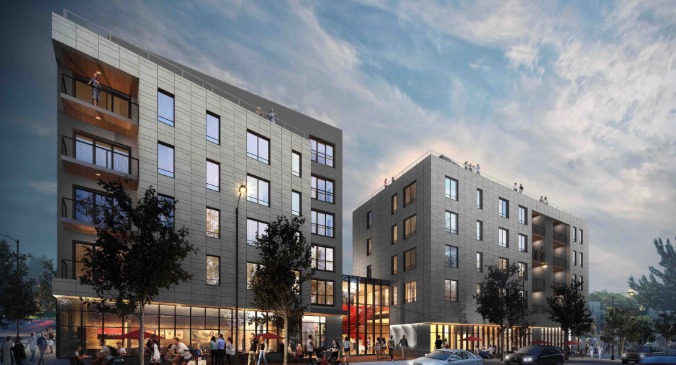Over the past ten years, the 35-year-old Olympic gold medalist, ten- time world title holder in a record six weight classes and Grammy-nominated recording artist has been assembling a business empire known as Golden Boy Enterprises. De La Hoya brings to those ventures, which include multifamily housing, the same talent, tenacity and commitment to hard work that made him almost unbeatable in the ring.
He learned to fight growing up on the streets of East L.A., the son of Mexican immigrants. “I saw my first boxing ring when I was three and began boxing at the age of six, encouraged by my father and grandfather, who also were boxers,” De La Hoya said. His talent became apparent early on.
“But I also was willing to work hard, to commit much of my time and to sacrifice other things that teenagers like to do in order to achieve my goal of becoming a champion. Winning a gold medal in 1992 was a dream come true and set me on a course to success in all aspects of my life. I never have given up that strong work ethic and have applied the same dedication and determination I learned in boxing to all aspects of my business and personal ventures,” said De La Hoya, whose professional and private lives are firing on all cylinders.
In 2001, De La Hoya married Puerto Rican singer Millie Corretjer and the couple have two children, Oscar Gabriel and Nina Lauren Ninette.
“Ever since I met her my life has been different. I have what I want,” said De La Hoya.
But as a teenage boxing star suddenly worth millions, he was seduced by life in the wild and fast lane and duped by a shady business advisor, according to a recent press release from HarperEntertainment, an imprint of Harper Collins Publishers, which plans to publish and release De La Hoya’s autobiography in June.
Today he is guided by his investment manager, Richard Schaefer, former managing director, head of the Western Region and deputy CEO for Private Banking North America at UBS, who joined team De La Hoya in 2000 and serves as CEO of Golden Boy Enterprises. And, today business is good.
His holding company recently added a significant ownership interest in the Houston Dynamo soccer team and his other investments include a boxing promotional organization, newspapers and boxing magazines, and a commercial and residential real estate company aimed at the Latino market.
He also owns the Golden Boy Building in Los Angeles, a 12-story office tower purchased in 2002 for $15 million that serves as headquarters for Golden Boy Enterprises and houses Golden Boy Promotions, his boxing promotion company.
“I founded Golden Boy Enterprises to serve the growing Latino population in the U.S. with investments in several major-market Spanish-language newspapers, in consumer brands and technology related companies,” said De La Hoya, adding that one venture in particular is very close to his heart–Golden Boy Promotions, through which he became the first Latino to own a national promotional boxing firm and one of only a handful of boxers in history to move into the field while still boxing professionally.
“I founded that company to rebuild and expand the popularity and fan base for boxing. In six years we have become one of the leading global boxing promotion companies, with 50 fighters under contract,” he said. Last year, that business generated 65 percent of all pay-per- view (PPV) event revenue in the U.S., much of it attributed to De La Hoya’s own fights. His match with Floyd Mayweather Jr. in May 2007, which ended in a 12-round split-decision loss for De La Hoya, brought in $134.4 million of domestic revenue and 1.4 million in PPV buys, making De La Hoya the all-time leader in PPV sales and single-event revenue, outreaching the previous leader for PPV buys of $1.9 million set by the 1997 ear-bite rematch between Evander Holyfield and Mike Tyson and the $112 million revenue record for a single event set by the 2002 Lennox Lewis/Tyson heavyweight title bout.
The Golden Boy is scheduled to face Steve Forbes in the ring on May 3 and Mayweather again in September for the WBC welterweight championship. That bout could be his last, although there is talk of another match being planned for December. As of press time, the exact date of the De La Hoya/Mayweather rematch had not been finalized.
What does De La Hoya think about when he laces up his gloves and steps into the boxing ring?
“The excitement of the sport. The challenge of a strategy for each round. The cheer of the crowd when I land a good punch,” he told MHP last month.
And, while he will miss stepping into the ring and the excitement that goes with it, he stated, “I am not retiring from boxing. I will continue to be active through Golden Boy Enterprises and expect to be promoting the biggest fights you will hear about. We have brought new energy and new ideas to boxing promotion and I look forward to taking it to even higher levels.” He also plans to concentrate fully on his various business interests. “Certainly I intend to spend more time on real estate development, because it is a field I love,” he said.
Ring to real estate arena
De La Hoya’s interest in real estate sparked as he traveled the country in his boxing career and was struck by the need for improving the quality of life in urban Latino communities. “I realized that real estate was the one area where I could make the most impact for my community. Real estate can change the entire complexion of a community; it can build a sense of pride that you don’t get through any other economic development. The opportunity to own a home or a business fosters a sense of ownership in one’s neighborhood and community that leads to increased safety, reduced crime, higher property values and greater self and family esteem,” he said.
His investment manager, Richard Schaefer, introduced De La Hoya to Highridge Partners CEO John S. Long, who has acquired, developed or financed more than $6 billion of real estate in California, Arizona, Nevada and Texas and is active in the United States, Europe and China. Long and De La Hoya formed Golden Boy Partners in 2005 with a shared $100 million investment.
“Schaefer realized that we both shared deep common values and commitment to invest in and revitalize urban, Latino-based communities. Both of us grew up in the inner city of Los Angeles.
Both of us wanted to return to our roots and apply our experiences to create opportunities for others growing up today in the inner city,” said Long, who left China as a child after the Communists took over his family’s grocery stores. He arrived in the U.S. in 1954 and grew up in South Central Los Angeles.
Long received a degree in economics from UCLA before applying to Harvard, where he obtained his MBA. “I wanted the finest business education available and knew it would open doors for relationships and contacts throughout my business career. I went into real estate because I saw it was mostly a seat-of-the-pants industry and I felt I could bring discipline and economic underpinnings that would give me an edge in the industry. Plus, being an entrepreneur was in my DNA and real estate is the ultimate entrepreneurial business. I would say that drive and determination to win are at the core of how Oscar and I approach our businesses and what makes us successful,” said Long.
He worked for KB Homes from 1971 to 1978, when he launched Highridge Partners.
De La Hoya believes that real estate is in his blood, as well. “I always have believed that success is 99 percent preparation and I find that is true whether you are getting into the ring or into the real estate business. Real estate is a lot like boxing in that you have to invest a lot of time and money before you are ready to step into the ring. Instead of training for several months, however, it can be several years before you find the right site, acquire it, decide on the right project for the community, design it and cost it, and secure all the government approvals you need to build,” he said.
With upheaval in the credit markets, those hurdles are even more pronounced. “Every aspect of development is under tremendous pressure in today’s financial meltdown environment. We, fortunately, are equipped to deal with these conditions, and Highridge Partners’ trademark over the last three decades is to expand when adverse conditions give rise to unusual opportunities,” said Long, who is considered contrarian by many of his peers.
But one off-and-on-again transaction that has received a lot of media attention illustrates the difficulty of getting any deal to pencil-in when the market is changing rapidly. One mark of experience is the knowledge of when to proceed and when to pull back. Last July, Golden Boy agreed to purchase a 23-acre site in East Los Angeles’ Boyle Heights sub-market for more than $70 million from MJW Investments, Inc. The industrial site houses a 1.8 million sq. ft. complex with a Sears retail store that De La Hoya frequented as a child and a long- closed Sears warehouse facility. Zoning and entitlement changes would be necessary for Golden Boy to realize its plans for a mixed-use project with housing and retail. Several previous attempts by other developers to redevelop the difficult site had failed and Golden Boy has put that deal on hold.
“Sadly, the deal is now off indefinitely. We invested an enormous amount of time, money and caring to get our vision for the Sears site off the ground. However, the complexities of the site and an uncertain economy make the project economics increasingly unviable.
We hope that we may have the opportunity to revisit the project at a later date because we continue to believe it has great potential as a source of new revenue to the city and as a catalyst to revitalize Boyle Heights, provide the community with services it so dearly needs and deserves and upgrade infrastructure that has been ignored for decades,” Long said, adding, “Stay tuned.”
Meanwhile, Golden Boy has seven projects under development totaling more than $100 million, four of which are multifamily for-sale. “We are focused on two primary objectives–residential and retail–but will incorporate office and other commercial as appropriate. As real estate professionals, we have to respond to the demand in the market in order for these projects to be financially feasible. The current demand is strongest for retail and residential in most of the markets we target. In some urban centers we could see more office demand and will incorporate that product if it fits. In rough percentages, approximately 50 percent of our projects are residential or mixed-use and 50 percent are retail or commercial,” said Long.
He believes that affordable workforce housing for the Latino population in inner city locations, both for-sale and rental, is the market segment that is most under served, even though the Latino demographic is the fastest growing in the nation.
“By 2020, it is anticipated that Latinos will make up more than 50 percent of all residents in Los Angeles County,” said De La Hoya. He agrees with Long that Golden Boy can best serve this demographic and remain profitable by building market-rate housing without government subsidies, because those subsidies come with restrictions.
“There are lots of companies that are already working on subsidized housing. We are more interested in focusing on the more difficult challenge of creating the opportunity for home-ownership in these markets at prices that people who already live there can afford.
Ownership is what creates pride in a neighborhood and is fundamental to really changing these neighborhoods for the better. We will work with subsidies, but not at the expense of allowing real ownership.
Owning your own home is the beginning of creating so many good things in a person’s life and we are committed to making that happen in these neighborhoods. Further, we are finding a huge demand for workforce housing. Our most common conversation with staff and elected officials in cities that we are working with is about their concern that there are too few workforce housing opportunities,” said Long.
“We feel that there is a very deep market in our niche focus, a burgeoning market that is almost completely overlooked by mainstream developers and institutional investors,” said De La Hoya.
“This demographic and geographic are often overlooked because they are more challenging and require a different skill set as opposed to greenfield development. Often the projects are smaller and require more time, two items that turn off a large segment of experienced developers. It definitely requires more creativity and a willingness to consider a project in which it is not immediately obvious that many of the obstacles you are faced with can be solved and be financially viable.
“Highridge Partners has a background and extensive experience in very challenging deals and we enjoy and are enlivened by such challenges and we have been very successful at it. We have assembled teams of very talented people who are experts in each of the disciplines needed to solve these problems and coupled them with our guidance and reputation as savvy investors to attract the capital needed to develop in these markets. Very few real estate investors have the desire to work this hard,” Long said.
Another area of interest to Golden Boy, and one in which its principals believe they have an edge, is in providing capital for new and existing businesses that will foster creation of jobs and services within the Latino community. Institutional investors and other capital sources have been looking at emerging domestic markets for the past decade, but, as noted by Betsy Zeidman, director of the Center for Emerging Domestic Markets at the Milken Institute, reaching these under served markets is a specialized process that requires an in-depth understanding of the market and the ability to break through informational and transactional cost barriers. Today, Latinos and African Americans are turned down for business loans at three times the rate of whites with equivalent credit characteristics.
“We expect to support business formation in a couple of our upcoming projects that will lend themselves to a greater mix of residential, retail and office. Just like real estate, we have found that great businesses can be found in inner city areas. Sometimes all they lack is the right source of capital and the right partner.
“Even in today’s turbulent market, we continue to believe that those well-capitalized organizations with a deep management bench and the ability to be very agile will lead the recovery, generate significant risk-adjusted profits for partners and capital providers and enhance the very communities that are under served. Golden Boy Partners is poised to be that type of leader,” said Long.
















